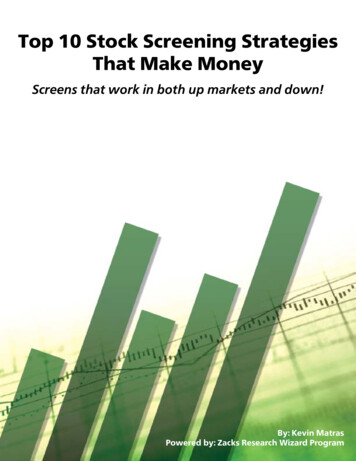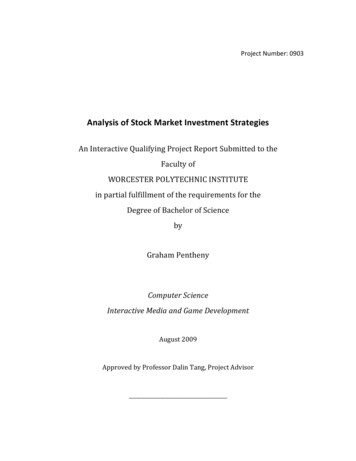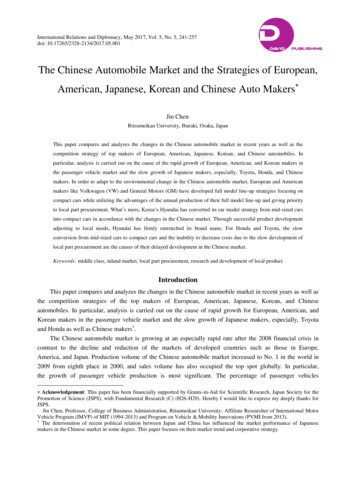
Transcription
Trading Strategies of TOP Market Professionals1
Trading Strategies of TOP Market ProfessionalsTrading Strategies of TOPMarket ProfessionalsCopyright 2012 TradersLogDISCLAIMER: There is a substantial risk of loss in trading stocks, futures,options and forex. Past performance is not indicative of future results. Theinformation and data in this ebook were obtained from sources consideredreliable. Their accuracy or completeness is not guaranteed and the giving ofthe same is not to be deemed as an offer or solicitation with respect to thesale or purchase of any securities or commodities.2
Trading Strategies of TOP Market ProfessionalsTable of ContentsJames ChenPart 1: The Deep Pullback .4Tim RacettePart 2: How to Profit from Market Retracements.10Matt BlackmanPart 3: Are You Trading with the Right Stuff? .18Kathy LienPart 4: Forex – How to Trade News .29Michael CarrPart 5: Testing Simple Strategies: MACD Works and Futures are Rewarding.37Jason Alan JankovskyPart 6: Catch a Falling Knife .43Dave LandryPart 7: The Power of Persistency.54Andrei KnightPart 8: Leading Signals with Lagging Indicators? .68Derek FreyPart 9: One Traders Journey .78Ann C. LoguePart 10: Managing Money to Stay in the Market .85Robert A. GreenPart 11: The Basics of Trader Tax .923
1Trading Strategies of TOP Market ProfessionalsPart 1: The Deep PullbackBy James Chen, CTA, CMTWHEN TRADING IN THE FOREX MARKET, traders who wish tomaximize their probability of success should pay close heed toseveral key principles and practices. This article discusses someof these principles and then provides a specific, step-by-stepstrategic method for putting them into effective practice.First and foremost, traders should always apply prudent riskmanagement. Good risk management fosters longevity intrading, and traders should ALWAYS strive to target longevity.Only through surviving to trade another day can a trader trulyhave any chance of achieving consistent profitability. Theproper practice of risk management primarily involves theactive limiting of market risk, most often through the wiseplacement of stop losses.The second key principle is to follow the prevailing trend.Though this principle is often over-eagerly touted by marketgurus and educators, its importance cannot be emphasizedenough. While there are successful counter-trend traders in allfinancial markets, trading with a strong, prevailing trend is oneof the best ways to take advantage of existing marketmomentum. One of the most important primary factors ofsuccessful trading is simply making sure that one’s directionalbias is correct, and that one stays on the correct side of themarket. By trading ONLY WITH the trend, this feat is more4
Trading Strategies of TOP Market Professionalsreadily accomplished. Trading with the trend is essentiallytaking the path of least resistance.The third key principle is to exploit pullbacks within a trend(dips in an uptrend or rallies in a downtrend), whereverpossible. Pullback trading epitomizes the sensible act of seekingoptimal trade entries within trends. In an uptrend, entering along trade on a downside pullback is ideal because the traderbuys into the trade at a lowerprice, in anticipation of sellinghigher for a profit on a potentialuptrend continuation. By thesame token, in a downtrend,Trading with the trendis essentially taking thepath of least resistance.entering a short trade on anupside pullback is ideal because the trader sells short into thetrade at a higher price, in anticipation of buying back (orcovering) lower for a profit on a potential downtrendcontinuation. Pullback trading is common, but the intelligenttrader should not just look for any pullback that occurs, as theycan often quickly turn into reversals of the trend. Rather, the keyevent to look for is the pullback RECOVERY, where price beginsto recover from the temporary pullback and starts to move backin the direction of the prevailing trend, thereby providing someindication of a potential trend continuation.The fourth key principle to be discussed here involves ensuringa prudent reward-to-risk ratio. Generally speaking, this meansthat traders, and especially trend-following traders, should seektrades having potential reward (profit) significantly exceedpotential risk (loss). Particularly when dealing with trend trades,5
Trading Strategies of TOP Market Professionalshaving a relatively high reward-to-risk ratio allows for lessfrequent (but substantially larger) winning trades toovershadow more frequent (but substantially smaller) losingtrades, thereby targeting net profitability. There are manydifferent ratios that different traders use for different purposesand strategies. Common ratios, depending on the trader and thecircumstances, include 2:1, 3:1, and 4:1. A 3:1 reward:risk ratio,for example, simply means that one strives to make one’swinning trades at least three times the size of one’s losingtrades.With these prudent principles of high-probability Forex tradingkept firmly in mind, the trader can then look to formulate aspecific trading strategy that effectively puts these principlesinto practice. One solid strategy that fits these principles well isone that I have coined, the Deep Pullback.The rationale for this trading strategy is straightforward – a costeffective location to enter into a trend trade is where pricebegins to recover from a significant (hence, “deep”) pullbackwithin a strong trend. In an uptrend where a trader is looking tobuy, or go long, the most cost-effective location for entry is aftersubstantial price dips, optimally getting the trader into theuptrend at a relatively low price. In a downtrend where a traderis looking to sell short, the most cost-effective location for entryis after substantial price rallies, optimally getting the trader intothe downtrend at a relatively high price. If the correction doesnot turn into a trend reversal, a deep pullback is better than ashallow one simply because the entry on a deep pullback occursat a more advantageous price than on a shallow pullback.6
Trading Strategies of TOP Market ProfessionalsWhen a deep pullback occurs, trade entry should be consideredonly if price indicates a potential RECOVERY from the pullbackby turning back in the direction of the prevailing trend. Oncethis occurs, a trade with the trend can be entered and riskcontrol measures can then be set in place, along with a potentialprofit target according to the trader’s desired reward-to-riskratio.The setup is simple. Hourly or other short-term charts of majorcurrency pairs are scanned for the following criteria.1) The first criterion is trend. A trend is in place only if thereis separation and a Correct Order of Moving Averages(COMA) – in this case, three simple moving averages (SMA):50, 100, and 200 periods. For an uptrend, the correct orderof moving averages consists of the 200-period SMA on thebottom, followed above it by the 100, with the 50 on top.For a downtrend, the correct order of moving averagesconsists of the 200-period SMA on top, followed below it bythe 100, with the 50 on the bottom. If this first criterion isfulfilled with a COMA, the second criterion should then beconsidered.2) The second criterion is the deep pullback. Within a trendas defined by the first criterion, a trade is considered onlyif price moves deep enough – to the 100-period SMA ormore. Therefore, in an uptrend, a pullback dip isconsidered deep enough only if price moves to the 100period SMA or lower. In a downtrend, a pullback rally isconsidered deep enough only if price moves to the 100-7
Trading Strategies of TOP Market Professionalsperiod SMA or higher. If this second criterion is fulfilledwith a deep pullback that goes to the 100 SMA or more, thethird criterion should then be considered.3) The third criterion is a pullback recovery. This is indicatedin an uptrend by the Slow Stochastics main line crossingand closing above the oversold (20) line after having beenpreviously oversold, or on a downtrend by the SlowStochastics main line crossing and closing below theoverbought (80) line after having been previouslyoverbought.The Deep Pullback on a GBP/USD hourly chart uptrend (chart courtesy ofFXDD-MetaTrader)Once all three criteria are met, a trend trade may be enteredimmediately on the fulfillment of the third criterion. After entry,for a long entry in an uptrend the stop-loss can then be placedjust a few pips below the low of the pullback dip. For a shortentry in a downtrend the stop-loss can then be placed just a fewpips above the high of the pullback rally.8
Trading Strategies of TOP Market ProfessionalsWith strictly-controlled, defined risk in place, attention can thenbe placed on targeting profits through the use of apredetermined reward-to-risk ratio. For example, if operating ona 3:1 reward-to-risk ratio (where reward is set at three timesrisk) in an uptrend, the trader would take the size of the definedrisk (entry price minus stop-loss price), triple this risk amount,and then add that value to the entry price to derive the profittarget price.The Deep Pullback strategy can be employed as a robust tradingmethod that fulfills some key principles of high-probabilitytrading. The strategy’s strict, built-in trading criteria filter outlower probability trades and present potentially higherprobability trades which, when coupled with strong riskmanagement, can contribute significantly to an effective overalltrading approach.James Chen, CTA, CMT, is a highly-experienced trader, analyst, and author,and is currently Director of Technical Research and Education at FXDD, aglobal leader in foreign exchange trading. He is also a Chartered MarketTechnician and a registered Commodity Trading Advisor. Chen is the authorof Essentials of Foreign Exchange Trading (Wiley, 2009), Essentials ofTechnical Analysis for Financial Markets (Wiley, 2010), and the DVD-set,High-Probability Trend-Following in the Forex Market (FX Street, 2010). He isalso a frequent speaker and contributor to key financial media, includingReuters, Dow Jones, Bloomberg, and Forbes.9
2Trading Strategies of TOP Market ProfessionalsPart 2: How to Profit from MarketRetracementsBy Tim RacetteWHAT IS YOUR #1 JOB AS A TRADER? A trader’s main job is toorganize market information into an identifiable sequence,providing an edge. This edge is the result of a statisticaladvantage from a given set of trades over time.In this article we will look at how to Determine an edge in the context of the larger trend Enter into a trade at a predetermined retracement level Understand market behavior and avoid commonchallengesThe market is said to be continually retracing. At a quick glanceof any basic chart it’s pretty apparent. The market goes up, itpulls back, and it goes up again. Other times the market goesdown, rallies, and goes down again. Time after time the processrepeats itself.So how then do we make sense of the market information? Onemethod is to identify the larger trend and look to enter in thedirection of that trend once a retracement has occurred.What is a Retracement?A retracement is simply a short-term reversal in the trend, apullback in an uptrend or a rally in a downtrend.10
Trading Strategies of TOP Market ProfessionalsThe market rarely moves higher or lower in a straight line. Aftera market has made an initial push, we often see a reversal, aretracement in price. Given the frequency of this occurrence weare able to get into the market at this retracement level and takepart in the larger move.How to Think Like a TraderIt’s time to train your brain to think like a trader and trade offwhat you see, not what you think. Traders think with their eyes,not with their brains. Said another way, traders do not try andpredict what will happen; they trade off the data in front ofthem.Remember the market is always right and anything can happen.The Psychology Behind the MarketForget about Fibonacci, Moving Averages, or fancy indicators fora minute. Let’s try and understand what is happening on apsychological level when price breaks out and pulls back.Example: A group of investors believe a market is going higher sothey begin to buy in large size. This slowly pushes the markethigher. Traders notice the movement and begin to jump on board.After breaking highs the move higher becomes clear. The retailtraders feel they will miss out of they don’t get in now so theyproceed to buy last, and at highs.The professional traders and shorter-term hedge fund playersclose out their positions as we make new highs. And who do theysell to? Why to the retail traders that were chasing the move. It’sat this point that the market begins to selloff.11
Trading Strategies of TOP Market ProfessionalsOnce we have pulled back say halfway, the original investorsdecide to add to their position just as the retail traders who werechasing the move are getting their stops hit and exiting for a loss.With investors adding to their already profitable position thissends the market higher once more, and the process repeats.When to Place Your TradeBuying pullbacks in an uptrend and selling rallies in adowntrend is a great strategy, but how do we know when theshort-term reversal is over and the larger trend is ready toresume? We don’t. What we do know, is that markets tend toretrace
readily accomplished. Trading with the trend is essentially taking the path of least resistance. The third key principle is to exploit pullbacks within a trend (dips in an uptrend or rallies in a downtrend), wherever possible. Pullback trading epitomizes the sensible act of seeking optimal trade entries within trends. In an uptrend, entering a











